Gastronomy of ESTADO DE MEXICO
Mexico » States » Estado de Mexico » Gastronomy
Cover photo by larutadelagarnacha.mx
Typical Food of ESTADO DE MEXICO
Estado de Mexico (State of Mexico) is renowned for its rich culinary traditions, with a menu that includes a wide range of dishes prepared from fruits, vegetables, cereals and other natural ingredients that are locally grown. While the urban areas in the state have grown and the natural environment has been affected, the gastronomic traditions still prevail.
Corn and beans are the most important crops grown in the state, but various cereals, fruits and vegetables are also produced. The cuisine of the state is a blend of the ancient and modern world, with the influence of various cultures, including the Mazahua, Otomi, Nahua, Matlazinca and Tlahuica cultures, evident in the cuisine.
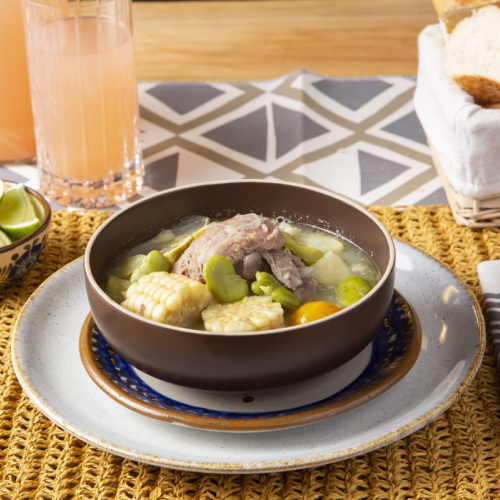
Corn and beans form the basis of many of the state’s culinary offerings, with a variety of tamales available. The tamales come in many forms and are filled with chickpeas, broad beans, ram, chicken, barbecue, rabbit and more. Epazote-cooked beans accompanied with cheese and sausage are also popular dishes. During the rainy season, from May to October, many varieties of edible mushrooms such as cloves, trotters, morels, and yolks are available, which are used to make numerous dishes.
Visitors to the State of Mexico usually head to San Martín de las Pirámides, Acolman and Malinalco for their placero tacos; to Villa Guerrero for pepeto; to the Marquise for marinated rabbit; to Tenancingo for bishop tacos with spicy green sauce; to Ocoyoacac for bean pancakes; and to Toluca for Toluqueña torta. Additionally, a variety of dishes such as Pancita (tummy), barbecues, pork stews, charal tamales, trout and mojarras are available. In season, acociles, grasshoppers, and escamoles, along with tasty maguey worms, are also available to be savored.
Apart from these, the cuisine of the State of Mexico offers an extensive variety of desserts and drinks. The traditional drink, “mosco” or “mosquito,” made with sweetened fruit, especially orange, is very popular. Other drinks include fly, pulque, Atole de pinole, and chacualole. Desserts include pinole or corn croquettes, hawthorn jellies and ates of capulín, tejocote, pear, apple, quince and fig, pepitorias, charamuscas, and ponte duro.
The state’s culinary delights are not limited to chorizo and pork. Green chorizos, charales roasted in corn husks, goat or lamb barbecues, ximbó, a taco with maguey worms, the abispos, rabbit mixiotes, battered squash blossom pancakes, breaded chard stalks, quintoniles with onion, mushrooms in pasilla chile pepper, peas with mushrooms, and pepeto are some of the dishes that the state’s cuisine offers.
The typical dishes of the State of Mexico are among the country’s greatest attractions. The culinary traditions are a blend of flavors, and the unique cuisine is the result of the influences of the various cultures that make up the state. The cuisine of the State of Mexico is a great reason for tourists to visit the area and sample the diverse offerings. With traditional as well as international cuisine, the state is home to an excellent gastronomy that should not be missed.
Typical Dishes of ESTADO DE MEXICO
Pancita
One of the most popular dishes of the State of Mexico is the pancita, a hearty and flavorful stomach broth made from beef or lamb. This dish is seasoned with pasilla and chilaca chili sauce, garlic and epazote, which gives it a unique and distinct taste. Pancita is typically served with chopped onion, lemon, oregano and tortillas.
Although this dish can be found throughout Mexico, the classic version of pancita is said to originate from the State of Mexico, where it is enjoyed by locals and visitors alike. The most famous variants of pancita are cooked in Naucalpan and Metepec, two cities in the State of Mexico.
Green Chorizo (Green Sausages)
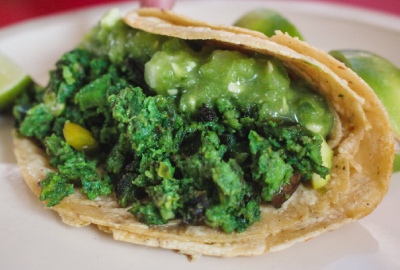
Another typical dish of the State of Mexico is the green chorizo, which has become a symbol of the city of Toluca. Green chorizos are made with a mixture of beef and pork, seasoned with a variety of herbs and spices, including spinach and Serrano chiles. The distinctive green color of the sausage is due to the presence of a large amount of spinach, which also gives the dish its healthy properties.
Green chorizos can be enjoyed as a taco filling or served on their own. This dish was created in the 1960s as a variation of the traditional red chorizo, which became too expensive. The green chorizo quickly became a hit and has remained one of the most popular dishes in the State of Mexico to this day.
Bishop and Almond Chorizo Tacos
Tacos are an integral part of Mexican cuisine, and in the State of Mexico, they are a beloved street food that you can find almost anywhere. Whether you prefer chorizo, cecina, steak or chicken, tacos are a must-try when you visit the region. In Tenancingo, you can try the bishop’s tacos, which are made with bishop and red chorizo.
Tepetlixpa is known for its cecina tacos, while Toluca is famous for its chorizo tacos. No matter where you go, you should always accompany your tacos with cilantro, parsley, a well-made sauce or sliced or whole green chiles.
Melted cheese with chorizo
This dish is a gastronomic delight that has won the hearts and taste buds of the local population. The combination of the creamy and mild flavor of melted cheese with the strong and spicy taste of fried chorizo creates a perfect balance of flavors. The recipe is simple and easy to prepare, making it a must-try for anyone looking to explore the flavors of the State of Mexico.
All you need to do is crumble and fry the chorizo, then place it in the oven with grated cheese. Serve it with tortillas or bread, and you have a perfect accompaniment to any main dish. Melted cheese with chorizo is a versatile and fast preparation that is ideal for any occasion, from family gatherings to parties. Your guests will love it, and it will add a touch of joy and flavor to any menu.
Barbacoa (Barbecue)
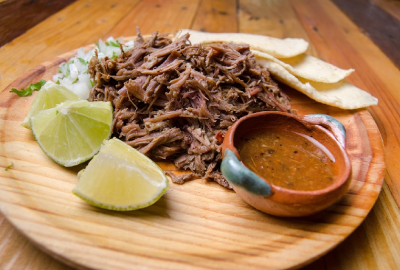
It is barbecued lamb or goat meat, which is wrapped in maguey stalks and cooked in an earthen oven. This cooking technique has its origins in pre-Hispanic times and has been perfected over the years. The meat is ventilated to withstand the heat of the barbecue, then covered with spices and agave leaves. Finally, it is cooked for hours until it becomes tender and juicy. The most classic version of this dish is with lamb meat, but in the State of Mexico, goat meat is also used, giving it a unique and delicious flavor.
Barbecued meat is typically served in tacos with onion, lemon, and a spicy sauce made with pasilla chili, garlic, onion, and pulque. If you’re visiting Texcoco or Capulhuac, you’ll find the best barbecued meat. This dish is a staple in the State of Mexico and is not to be missed during your visit. Goat meat is high in protein, zinc, and other nutrients that are essential for the proper development of the body and its defenses.
Pepeto
Pepeto is a traditional broth made with pork and chilacayote, a variety of pumpkin native to Mexico. This dish is often consumed to relieve hangovers, but it is delicious any time of the year. To prepare it, boil the pork until it becomes tender, then add chopped chilacayote and corn. Add broad beans and finely chopped manzano chili, season with epazote and salt, and voila! You have a hearty and flavorful broth.
Pepeto is a must-try when visiting Tonatico, a picturesque colonial city in the State of Mexico. Chilacayote is an ideal ingredient for people with diabetes, as it contains hypoglycemic agents that help lower blood sugar levels. It is also a powerful antioxidant due to its high content of vitamin A and iron.
Pumpkin Flower Pancakes
Pumpkin flower pancakes are a delicate and tasty meal that are easy to prepare at home. The main ingredients are pumpkin flowers and cheese. To make them, start by taking washed flowers and filling them with cheese, like a cake. Then, pass them through beaten eggs and flour, and fry them in hot oil until they are crispy on the outside and have a soft center of melted cheese. These pancakes can be accompanied by typical drinks from the State of Mexico, such as the famous aguas frescas, for a complete culinary experience full of flavors and textures.
Pumpkin flowers have various health benefits, especially for the sense of sight due to their high levels of vitamin A, which can help delay the damage of aging and prevent the formation of cataracts and retinopathy. Additionally, they promote the formation of white blood cells, which can help strengthen the immune system.
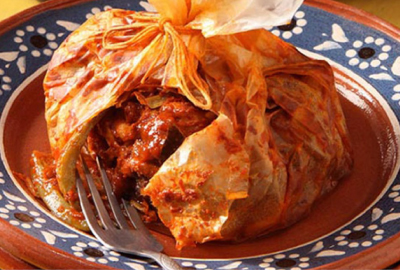
Mixiotes
Mixiotes are prepared in various parts of the State of Mexico, but some of the best are made in Amecameca. This dish involves steaming different types of meat and sauces inside a leaf that comes from the membrane of the maguey stalk. Among the most popular mixiotes are those of pork in green sauce with nopales and epazote, as well as the red chicken with guajillo chili sauce, cumin, cloves, and xoconostles.
The pulquero agave stalk has a fine membrane that covers it called a mixiote, which can be used to wrap food. This is the case of the rabbit mixiote, which is a gastronomic must-see that you should not miss trying. This is a recipe worthy of large events, but one that will be easy for you to prepare. You only have to macerate the rabbit meat in a sauce with spices and chili for one night. Then, place the meat inside the mixiote and cook it in a steamer until the meat is tender.
This is one of the representative dishes of the State of Mexico of pre-Hispanic origin, since the population of the Anahuac Valley was the first to use the mixiote to cook different types of meat. Many restaurants offer variations with rabbit or chicken, and even vegetarian versions. The rabbit is ideal to be complemented with low-calorie diets, since its light meat has low amounts of salt, ideal for those who accumulate fluids. In addition, its high selenium content is beneficial for the thyroid gland.
Battered Chard Stems
Battered chard stems or stalks are another must-try dish from the State of Mexico. With minimal preparation and cooking time, this dish will quickly become a favorite in your kitchen. To make it, simply take the chard and reserve its stems. Boil them in salted water for a few minutes. Then, beat an egg and once the stems are boiled, pass them through the egg and breadcrumbs. Finally, fry them until crispy and they will be ready to eat.
Swiss chard is incredibly good for your health due to its enormous amount of vitamins and minerals. It also provides omega 3, which can help reduce cholesterol and triglycerides to optimal values for the functioning of the body.
Tamales
These corn-based treats are filled with a variety of ingredients and wrapped in corn husks or banana leaves before being steamed or boiled. The State of Mexico has its own unique types of tamales, including those filled with capulín (a type of wild cherry), mushrooms, and totomoches (a type of giant purple bean).
If you’re in the mood for capulín tamales, head to Tlalmanalco, where you can find some of the best examples of this traditional dish. Ocuilán, Chalma, and Malinalco are great places to try mushroom tamales, while Zumpango is known for its delicious totomoches.
Judas tamales
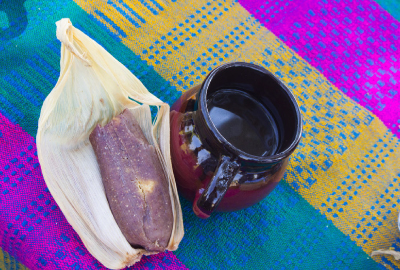
This special variety is only eaten during Holy Week and Lent and is made with a dry toasted blue corn dough that is flavored with cinnamon and sweetened with piloncillo (unrefined cane sugar). Ground pork is added to the dough, which is then wrapped in corn husks and cooked in boiling water.
Judas tamales are an important part of the state’s culinary traditions and are typically eaten on Saturdays during the burning of the Judas doll. You can find them in many markets throughout the State of Mexico, including the San Martín Caballero market in Nezahualcóyotl.
Blue corn, the main ingredient in Judas tamales, is known for its health benefits. It contains anthocyanin, an antioxidant that helps reduce bad cholesterol and improve circulation. Additionally, blue corn has a lower level of starch than other types of corn, making it a good choice for people with diabetes.
Totomoches
If you’re looking for a truly unique culinary experience, try the totomoches. These tamales are made with a corn dough filled with ayocote beans and flavored with epazote and poblano pepper. The totomoxtle leaf, which covers the ears of corn, is used to wrap the tamales before cooking. To make the leaves elastic, they must be soaked for a few hours before use.
It’s worth noting that Mexicans have a staggering variety of tamales, with between 500 and 5,000 different types depending on the region. Masses and fillings can vary widely, as can the leaves and sauces used to prepare them.
Wheat Pozol
In the charming towns of Almoloya de Juárez, Temoaya, and Lerma, an intriguing variation of the beloved pozol recipe takes center stage. Here, corn grains are replaced with wheat, resulting in a distinct and captivating flavor profile. The preparation process begins by scorching the ears of wheat, followed by grinding them on a metate to obtain the grains.These grains are then cooked with water, onion, salt, epazote, and pork, imparting a hearty and savory essence.
To elevate the taste, a guajillo chile sauce, along with onion, salt, and garlic, is added during the cooking process. The dish is finally served with a garnish of chopped onion and a dash of lemon. The wheat pozol offers a unique twist on a traditional favorite, showcasing the culinary ingenuity of the State of Mexico.
Maguey Worm Tacos
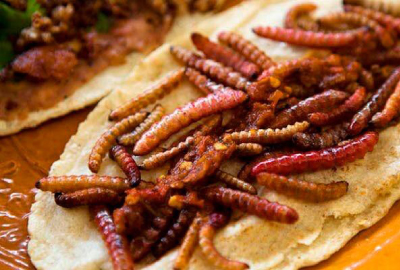
For those seeking an extraordinary and unforgettable culinary experience, indulging in maguey worm tacos is an absolute must when visiting the State of Mexico. These tiny worms, harvested after the rainy season from maguey plant leaves, offer a rare delicacy that will undoubtedly leave a lasting impression.
The worms are first fried with a blend of spices and then transformed into a flavorful filling for flour or corn tortillas. Accompanied by guacamole or other tantalizing garnishes, these tacos celebrate one of the region’s most important insects. Maguey worms have gained international acclaim in gastronomic circles due to their exotic and delectable nature.
Despite their small size, these worms pack a surprising protein punch, exceeding that of meat, while also boasting high mineral content. Embark on this gastronomic adventure and savor the peculiar delight of maguey worm tacos during your visit to the State of Mexico.
Quintoniles with Onions
For vegetable enthusiasts seeking a dish that satisfies their cravings, quintoniles with onion offer an enticing option in the State of Mexico. Indulge in this culinary delight during the rainy season, where numerous restaurants and inns proudly serve this flavorful creation. The star ingredients of this dish are quintoniles, complemented by garlic and onion.
The preparation involves frying the quintoniles before adding broth and seasonings. Allowing the broth to reduce over gentle heat enhances the dish’s richness, creating a delightful and comforting experience when served hot. Quintoniles, the leaves of the quelite plant, hold a significant presence in the cuisine and customs of the State of Mexico when they are in season.
These delectable greens serve as ideal accompaniments to delicious meats or even as fillings for vegetarian tacos. Additionally, quintoniles offer a healthy dose of fiber and vitamin A, promoting intestinal health and aiding in relieving constipation. The plant’s medicinal properties have long been recognized, with applications ranging from astringent concoctions to therapeutic massages.
Mushrooms in Chile Pasilla
For vegans and vegetarians, State of Mexico offers a delightful dish called Mushrooms in Chile Pasilla. This culinary creation features mushrooms and pasilla chili peppers as its main stars. The preparation begins with the careful processing of pasilla peppers by removing the veins and grinding them with tomatoes and onions.
This flavorful paste is then fried, and sliced mushrooms are added along with enough water. The mixture is simmered on low heat for a few minutes, allowing the flavors to meld together. It’s interesting to note that pasilla chili peppers are a staple ingredient in many traditional Mexican moles, thanks to their mild yet distinct flavor. Additionally, these peppers are a year-round delight, as they are not overly spicy.
Rich in carbohydrates, vitamins, and lipids, pasilla chili peppers provide essential energy, promote cell development, and aid in hormonal regulation. So, whether you follow a vegan or vegetarian lifestyle or simply enjoy exploring new flavors, Mushrooms in Chile Pasilla is a dish that should not be missed.
Corn Croquettes

One of the simplest and most delicious desserts you’ll find in State of Mexico is corn croquettes. These delectable treats are perfect for snacking in the afternoon, especially when accompanied by a hot infusion. While most versions of this recipe involve shelling and grinding the corn, it’s not a mandatory step. The key is to mix the dough with eggs and sugar, shaping them into small discs, and frying them to perfection.
For an authentic touch, you can pair these croquettes with jocoque, a creamy dairy delight made from fermented milk. Whether you’re visiting a local restaurant or trying them at home, these corn croquettes are a must-try dessert that showcases the essence of State of Mexico’s culinary heritage. Not only are they delicious, but they also offer the nutritional benefits of corn, such as vitamins, minerals, and antioxidants. Don’t hesitate to give them a try – you won’t be disappointed!
Peas with Mushrooms
Mushrooms play a significant role in various traditional dishes of State of Mexico. As a region known for its wooded landscapes and cool climate, this state offers an ideal environment for constant mushroom production throughout the year. One such delightful dish that showcases the flavors of this ingredient is Peas with Mushrooms.
Combining the protein-rich goodness of peas with the earthy essence of mushrooms, this dish offers a flavorful and nutritious experience. The preparation involves creating a hearty broth using cooked peas or white beans, and then adding filleted mushrooms. For added flavor, you can season it with typical herbs like epazote and blended tomatoes.
This dish is perfect for enjoying on a rainy day, especially when paired with a traditional beverage from State of Mexico, such as pulque. Moreover, Peas with Mushrooms serves as an excellent main course option for vegans and vegetarians, providing a satisfying and wholesome meal. Not only do mushrooms enhance the taste of this dish, but they also offer numerous health benefits.
Typical Drinks of ESTADO DE MEXICO
When we think of State of Mexico, we often imagine sizzling hot dishes and refreshing cocktails, but there’s a lot more than that. In fact, one of the best ways to experience the country’s diverse culture is through its traditional drinks. If you’re looking for a unique and authentic drinking experience, look no further than the State of Mexico. Here are our top picks for traditional drinks from this vibrant region.
Sendecho
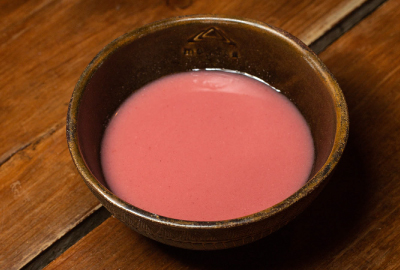
If you’re a beer lover, you won’t want to miss out on trying Sendecho, a pre-Columbian beer that has been enjoyed in the State of Mexico for centuries. This traditional drink is made from germinated yellow corn that is dried in the sun and then ground and boiled with honey or piloncillo. To create the final product, pulque or agave honey is added, and the mixture is fermented for several days. The result is a delicious and unique beer that offers a glimpse into Mexico’s rich cultural heritage.
Chiva
If you’re looking for a unique and flavorful liqueur, Chiva is a must-try. This green herbal liqueur hails from the magical town of El Oro and is made from 17 different ingredients, including anise. Originally, Chiva was consumed by miners to cure scares and regain courage, but over time it became popular for its medicinal properties, such as relieving digestive problems and reducing pain. Whether you’re sipping it for its health benefits or just for the taste, Chiva is a delicious and refreshing drink that will leave you feeling satisfied.
Fruit Liqueur
The town of Tenancingo is famous for its exquisite fruit liqueurs made with local fruits such as figs, quince, blackberry, hawthorn, and nanche, combined with brandy and spices such as anise or cinnamon. These liqueurs are not only delicious on their own but also serve as a perfect addition to cocktails and gastronomy. Both the drink and the ingredients used to make it are sold in town stores and Mexican markets.
Garañona
One of the most intriguing drinks you can try in the State of Mexico is Garañona. This green concoction is made by macerating cane alcohol with 14 different herbs until obtaining an intense and aromatic beverage. Its name comes from the myth that drinking it will make a man feel like a stallion, a womanizing man. Despite its mild taste, Garañona is a very strong drink, so it is recommended to consume it slowly and moderately.
This mysterious drink has a similar appearance and mysticism to European absinthe, which also contained various herbs in its preparation and promised interesting effects until it was banned. However, Garañona is not dangerous and can be enjoyed in the municipality of Metepec, at any time of the year. Its ingredients are a closely guarded secret, so discovering which herbs are used in its preparation will be a challenge.
Pulque
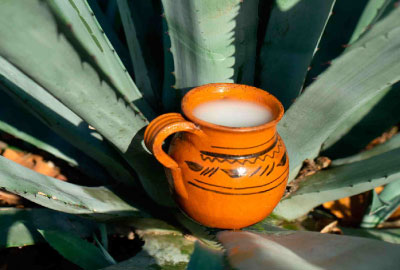
Pulque is another traditional drink that you must try when visiting the State of Mexico. It is a pre-Hispanic beverage that has been enjoyed for centuries and is still popular today. Pulque is made by fermenting the mead produced by the maguey pulquero, a type of agave that grows in this region due to its rocky soil and dry climate. This results in a viscous drink with a strong flavor and a bitter touch that you will not forget.
One of the best places to try pulque is at Casa Tinacal, a traditional pulquería located in Tlalnepantla that offers the drink throughout the year. You can also find pulquerías in other towns and cities in the State of Mexico. It is said that the drink was guarded by deities called Centzon Totochtin, who were worshiped for having shared their treasure with humans. When visiting Jiquipilco, don’t forget to ask the locals about their myths and stories related to this drink.
Aguas Frescas (Fresh waters)
Fresh waters are famous throughout Mexico for being refreshing and hydrating beverages that are perfect for hot days. In the State of Mexico, you can find different local flavors, such as aguas de capulines and nanche, which are fruit-based beverages. There are also traditional drinks like Jamaican flower and horchata, which are made with rice, cinnamon, and vanilla.
Aguas frescas are usually consumed for breakfast or as a midday refreshment. They are also a great way to hydrate during long walks or hikes. You can find them in markets such as Atizapan, in Zaragoza, or you can prepare them at home with your favorite fruits and sugar. Some people even add chili powder for a spicy kick.
Pinole
Pinole is a popular food in the State of Mexico, made from toasted cornmeal mixed with piloncillo and cinnamon. It is commonly added to atole and consumed all year round, but especially during the national month. Pinole is a versatile food that can be eaten dry or as a drink and is used in many typical foods and drinks in the State of Mexico. It is a fine cornmeal sweetened with piloncillo that can be eaten without cooking, and is often ground with orange peels and cinnamon. The pinole is used to make hot or cold drinks, with the most emblematic being the Mexican beer called tejuino.
The ancient cultures of Mexico used pinole to make fortifying drinks, ideal for long trips across the country. Over time, sugar was added, and it took its final form, as it is known worldwide. Eating pinole has several health benefits, such as reducing constipation due to its richness in fiber. It is also ideal for most diets, as it has a low caloric level, and it is even good for coeliacs due to its lack of gluten. The best thing about pinole is that you can consume it throughout the year, and it is a must-try food when visiting the State of Mexico.
Pinole Atole
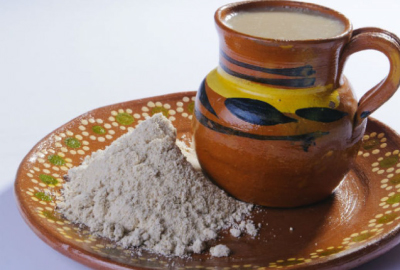
Pinole is a versatile food made from roasted corn that can be consumed dry or as a drink, with the most popular form being atole. Atole is a tasty beverage that is part of the traditional meals originating in the State of Mexico. To prepare the atole, the pinole is dissolved in water and placed on the fire. Cinnamon, sugar, and a little salt can be added to flavor it, and milk is then added and stirred until it thickens. Atole is served hot and can be consumed throughout the year. It is easy to prepare, and you can make it at home to share with your family and friends.
Eating atole is especially good for the stomach as it is easier to digest due to its high fiber content. Pinole, the main ingredient in atole, has all the benefits of corn, such as a significant amount of vitamins and antioxidants. Trying atole is a great way to experience the culture and traditional food of the State of Mexico.
Garapiña
If you’re looking for a more refreshing option than pinole, you can try garapiña, a fermented drink similar to tepache but with a more subtle flavor. It is usually clearer and lighter than tepache since it is prepared with pineapple pulp and sugar. Garapiña is a perfect beverage to cool down on a hot day and is commonly consumed in the State of Mexico.
Moscos or Mosquitos
The Moscos or Mosquitos, is a unique distilled and rested orange liqueur that was created in 1933 by Don Alfonso Almazán. This drink has a fascinating history that began in a small family liquor store in Valle de Toluca called La Miniatura. Don Alfonso was the mastermind behind this exquisite liqueur, which got its name from the chopped feeling it leaves in its consumers. Moscos or Mosquitos come in various degrees of graduations, such as “A” of 19 degrees, dedicated to ladies, “AL” of 31 degrees, for young people, “ALM” of 43 degrees, for gentlemen, and “ALMA” at 45 degrees, dedicated to mothers-in-law. The letters represent the first of the surname of its inventor.
Visiting Toluca without trying Moscos is like going to Acapulco and not taking a dip in the sea. Moscos have become an essential part of the State of Mexico’s culture and tradition, and their unique taste and history make them a must-have when visiting the region.
Piñas estilo Tenango (Tenango style pineapples)
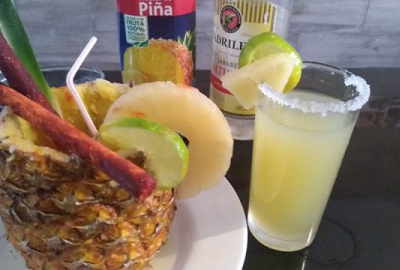
If you are looking for a unique mix of flavors with a touch of alcohol, Piñas, a traditional drink from Tenango del Valle, is a must-try. Piñas are made with candied pineapples, vodka, lemon juice, and syrup, and are served in a glass with a touch of salt and lemon that enhances the drink’s unique flavor.
Over time, this drink has undergone various modifications, without losing its essence. Blueberry liqueur (Piña Enamorado), coconut liqueur (Piña Acapulco), and Amaretto liqueur (Piña Xoly) have been added to its preparation. The variety of flavors and combinations is vast, making Piñas a drink that you can explore endlessly.
Chumiates
Chumiates is a popular drink in Tenancingo made with nanche, brandy, or cane distillate, and some aromatic herbs such as anise, tabaquillo, prodigious, chamomile, or lemon grass, among others. When ordering a Chumiates, the bartender would ask “for how many blocks do you want it?” because the closer you went, the more charged the glass was served. Chumiates is a drink that not only delights the palate but also provides an unforgettable experience.
Typical Sweets and Desserts of ESTADO DE MEXICO
The State of Mexico is known for its delicious and exquisite cuisine, and it is particularly famous for its traditional sweets and desserts. These delicious treats have been made for centuries in the region, and their ingredients, processes, and recipes have been passed down from generation to generation.
The range of traditional sweets and desserts made here is vast, and all of them are made with the utmost care and dedication. Many of these sweets have pre-Hispanic roots and have been modified over time to include colonial contributions, making them all the more flavorful and interesting.
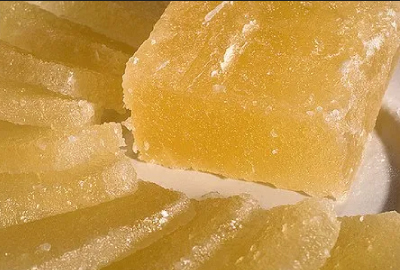
Crystallized sweets are very popular , and they are made from vegetables and fruits which are boiled in sugar or honey and then dried to harden. The process of crystallizing them is a lengthy one, and it begins with the vegetables and fruits being soaked in water with lime for a day before they are boiled and then submerged several times in brown sugar syrup and sugar. After that, they are boiled again and then left to dry in the open air to harden.
Another type of sweet that is popular in the region is the tamarind, or “Tarugo”, which arrived in the entity during colonial times. It is made from tamarind, sugar, and piquín chili, and it has a unique flavor. Sweets with milk and sugar, such as cocadas, jamoncillos, and macaroni, are also popular, as are those made with burned milk, such as amarantinas. Charamuscas and trompadas are made with piloncillo mixed with seeds, while meringues, sorbets, and duchess are made with egg white. Alegrías of amaranth and pepitorias of flour wafers, palanquetas and pepita sweets are also very popular.
The preparation of these sweets can take anywhere from one day to five days, depending on the type of sweet. They are often served during celebrations and bring delight to the palates of both children and adults. The State of Mexico is known for its delicious traditional sweets and desserts, which have been made in the region for centuries and continue to be a source of joy and delight.
Tejocotes
Mexico is a country rich in culture and traditions, where gastronomy plays a fundamental role in the celebration of its festivities. One of the fruits that has become part of the Mexican identity is the tejocote, also known as manzanita, which is a wild fruit with various uses in the Mexican territory. Its name comes from the Nahuatl “texócotl”, which means acid and hard fruit.
The tejocote is a small, round fruit with a bright orange-yellow color that is similar in appearance to a crab apple. It is usually harvested between September and December, making it a typical fruit during the Christmas season. During this time, you can find it in the traditional Christmas fruit punch, which is a popular non-alcoholic drink in the State of Mexico. The tejocote is boiled with other fruits and spices such as cinnamon and sugar, creating a delicious and aromatic syrup that is drunk warm.
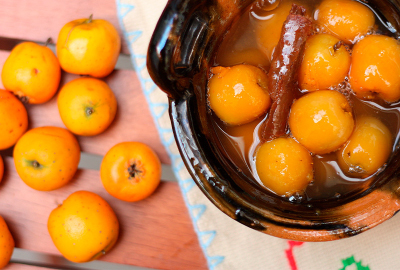
In addition to the Christmas fruit punch, the tejocote is also used in traditional Mexican sweets, including tejocote candy. The preparation of tejocote candy is simple; the fruit is boiled with sugar and cinnamon, creating a sweet and spicy treat that is enjoyed at room temperature. It is one of the most representative sweets of the State of Mexico, along with other traditional delicacies.
If you happen to visit the State of Mexico, be sure to try these typical dishes and sweets, including the tejocote candy and the Christmas fruit punch. You can find them in many local stores and markets, especially during the Christmas season. And if you want to take the taste of Mexico home with you, don’t forget to bring some tejocotes with you, so you can enjoy this unique fruit for a while.
Tejocote Jellies
If you thought that the tejocote was only used to make the Christmas fruit punch and sweets, you would be surprised to know that this exotic fruit can also be eaten as a delicious jelly. Tejocote jellies are a popular snack in the State of Mexico, and they are also great as gifts during the Christmas season.
Making tejocote jelly is easy, and it only requires a few ingredients. All you need is a casserole with sugar water and tejocotes. You let them boil until they fall apart, and then you let the mixture cool and set in containers. The resulting jelly is a sweet and tangy treat that can be enjoyed as a snack at any time.
But that’s not all; tejocotes are also a very healthy fruit, with numerous health benefits. They are rich in vitamin C, which improves brain health and encourages blood clotting, stimulating the production of hemoglobin in the body. They also contain fiber, which helps regulate digestion, and they are low in calories, making them ideal for weight management. Additionally, tejocotes make the immune system stronger and lower blood sugar levels, making them an ideal fruit for diabetics.
Capulín Ate
Capulín ate is a sweet and delicious preparation that is made from the capulín fruit. Capulines are small fruits that are very similar to cherries, but with a more acidic touch. This sweet treat is an essential part of the typical dishes and sweets of the municipalities of the State of Mexico. It is especially popular from June to September, when the fruit is in season throughout the state.
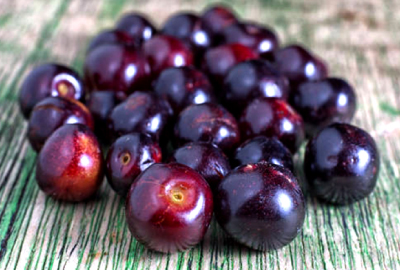
The ate has its origin in the time of the viceroyalty or colonial time, and it is a very popular sweet that at first was made only from quince. However, over time, it began to be made from almost any seasonal fruit. To prepare capulín ate, all you have to do is blend the fruit and boil it with sugar and apple peels. Once it thickens, refrigerate it, and it will be ready to taste.
Capulín ate can also be used to make ice cream and tamales, which work as a perfect dessert. This sweet preparation is not only delicious but also very nutritious. Capulines are a great source of antioxidants and vitamins, which makes capulín ate an excellent choice for anyone looking for a healthy and tasty dessert.
Chacualole
Chacualole is another traditional dessert from the State of Mexico that you cannot miss. It is consumed mainly in November, during the famous Day of the Dead festivities, which is one of the most important holidays in the country. Chacualole is a sweet pumpkin preparation that is sweetened with piloncillo. You can also include apples and guavas in the preparation to make it even thicker and tastier.
To prepare chacualole, all you have to do is place the fruits and piloncillo in a saucepan and stir until they dissolve. It is one of the main traditional desserts of the State of Mexico, and it is eaten cold together with the famous bread of the dead, which enhances its flavor.
This recipe is very familiar, and generally, in the houses of the locality, families gather to begin the elaboration of the dessert. Each family takes a turn stirring the casserole, because if left unattended for too long, the preparation will stick to the bottom and negatively change the flavor. This dessert is not only delicious but also a great way to bring families together and celebrate the Day of the Dead in a unique and meaningful way.
More Tourist Attractions in ESTADO DE MEXICO
Guided Tours in ESTADO DE MEXICO
Flights & Hotels in ESTADO DE MEXICO
More Tourist Attractions in MEXICO

Traditions in Mexico
It is practically impossible to make a meticulous, and above all, accurate selection of the places to visit in Mexico. Each place that our country houses is unique and beautiful in its own way. Mexico, with its nearly 2 million km², has a large number of scenarios to offer, as well as endless activities to do. Do not lose your way and enter the places to visit in Mexico. In Mexico, apart from the beaches and its famous archaeological sites, there are many other really interesting sites and activities that you should know. In the surroundings of the main cities you will find places full of culture and tradition, where you can spend relaxing, interesting and fun vacations. On your trip through Mexico you cannot stop obtaining souvenirs, the crafts that are made here are of the highest quality and recognized worldwide. A shopping tour cannot be missed.… Read More

States Of Mexico
Mexico has an incredible diversity of landscapes, where the beauty of its beaches, internationally recognized, stands out. In its vast territory of coasts, there are beaches of unparalleled beauty, and colorful landscapes. A large network of first-class hotels and tourist services is available to visitors to these beaches. Mexico is also mystical places, dotted with archaeological testimonies inherited from its original inhabitants. Monuments made by the Mayas, Aztecs and Toltecs are located in magical landscapes, like lighthouses in an ocean of natural beauty. They offer visitors buildings that tell their history, and museums that collect their cultural heritage. And that keep alive ancestral traditions, in ceremonies and festivals, where you can enjoy cultural activities and entertainment.… Read More

Capital Cities
Folklore, gastronomy, literary culture, art and exhibitions, is what you will find in the capitals of the states of Mexico. To the north, colonial Mexico, Puebla, Guadalajara, Guanajuato, the Sonoran desert and the California peninsula. To the east Veracruz and the gulf. To the west Acapulco, Oaxaca and Tuxtla Gutiérrez. And to the south the Riviera Maya and the pyramids of Chichén-Itzá, Tulúm and Cobá in Yucatán, Palenque in Chiapas, the cenotes, and the Central American jungles.… Read More

Archaeological Sites
The Archaeological Zones are the cultural past of every Mexican. You will be amazed at the ambient, nature and the environment that surrounds them. Climbing to the top or being around it will take us back in time to admire every detail. México is a country of culture and traditions, many of which we have inherited from the pre-Hispanic inhabitants of this vast territory, although it is true that there were more settlements in the central and southern part of the country, it is also possible to find some archaeological remains in the north.
… Read More

Gastronomy
The Gastronomy of Mexico has a great diversity of typical dishes, which is why it was recognized by UNESCO as Intangible Heritage of Humanity. The basic and representative ingredients of Mexican dishes are: corn, coriander, chili, beans, piloncillo, nopal and tomato. Mexican cuisine is also characterized by its sauces, which serve as an accompaniment to traditional dishes, prepared based on spices.… Read More

Ecotourism and Adventure
Mexico is one of the best countries for Ecotourism as it has a great variety of flora and fauna, as well as a large number of refuges for extraordinary species. You can enjoy recreational activities of appreciation and knowledge of nature through contact with it, such as: stargazing, observation of natural attractions, wildlife and bird watching. Throughout México there are more than 176 protected natural areas, 5 of them considered by UNESCO as Natural Heritage of Humanity. Just for this and much more, we believe that Mexico is a Paradise for Ecotourism.… Read More

Magical Towns
A Magical Town is a place with symbols and legends, towns with history that in many cases have been the scene of transcendent events for our country, they are places that show the national identity in each of its corners, with a magic that emanates from its attractions ; visiting them is an opportunity to discover the charm of Mexico. The Magical Towns Program contributes to revalue a set of populations in the country that have always been in the collective imagination of the nation and that represent fresh and varied alternatives for national and foreign visitors. A town that through time and in the face of modernity, has conserved, valued and defended its historical, cultural and natural heritage; and manifests it in various expressions through its tangible and intangible heritage. A Magical Town is a town that has unique, symbolic attributes, authentic stories, transcendent events, everyday life, which means a great opportunity for tourist use, taking into account the motivations and needs of travelers.… Read More

Beaches
On the Beaches of Mexico you can immerse yourself in the intense blue ocean of the Pacific bays, sunbathe on the shore of the warm and transparent waves of the Caribbean Sea in Quintana Roo or even rest on the beautiful coasts of the Gulf of Mexico. Mexican beaches hide wonderful secrets for the traveler. By visiting them, in addition to enjoying the excellent climate and water activities, you can discover splendid archaeological sites and interesting colonial cities without traveling long distances.… Read More

